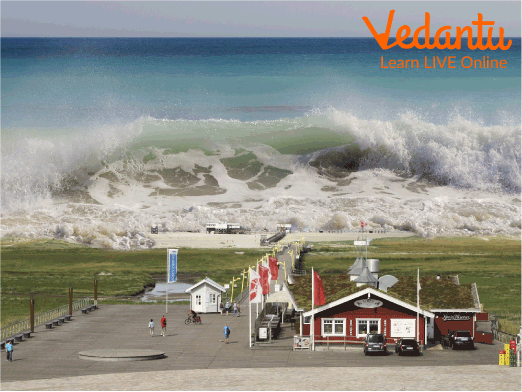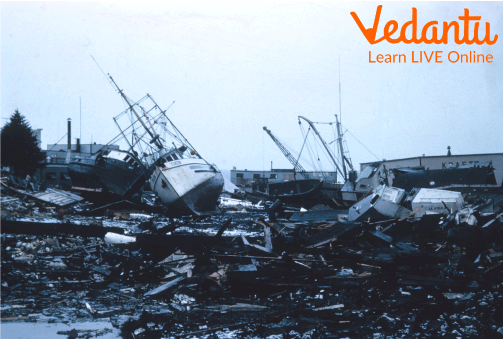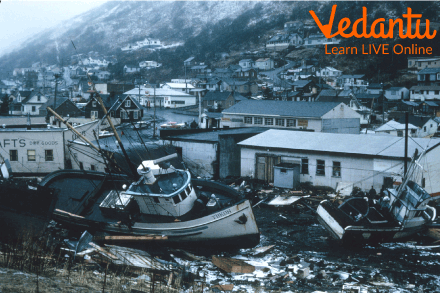




What Happens During Tsunamis?
Once the water is shaken by an earthquake or other event, large waves propagate from the point where the water previously moved. These waves can travel quickly and over very long distances. Some tsunamis have been known to travel thousands of miles across the ocean and travel at speeds of up to 500 mph.
As waves travel through deeper parts of the ocean, their summits are usually small, only a few feet tall. This makes tsunamis difficult to detect because they are not necessarily visible in the deep ocean. When waves approach land and shallow water, they pile up and increase in height. On the beach, a trough of the wave may be visible. This will cause a decrease in the shoreline. Water can seep for some distance. This can be dangerous as people may be tempted to hang out in an open area. When the wave hits the shore, it will usually be a long wall of water. The water would sometimes, for some distance, run inland with great speed and force.

Tsunami
Causes of Tsunamis
What Can Cause a Tsunami?
Tsunamis are caused by generating large waves in the seas/oceans. When you are sitting in the bathtub and you move in the tub, think. This can produce a relatively large wave. The same thing happens in the ocean when a large amount of water is suddenly gone. Such movements can be triggered by a variety of events, including earthquakes, landslides, volcanic eruptions, the break-up of glaciers, and even meteorites.
Most tsunamis are caused by earthquakes (when a large area of the Earth's crust suddenly moves). When this happens underwater, large gaps can appear on the ocean floor. When water moves forward to fill this gap, a tsunami is created.
Where do Tsunamis Appear?
Tsunamis can generally occur in sea areas. They are most common in the Pacific Ocean where there are a lot of underwater earthquakes and volcanoes. Long-term coastal countries on the Pacific Ocean such as Japan, Chile, and the United States are at risk of tsunamis. However, a tsunami can happen anywhere. In 2004, a massive earthquake in the Indian Ocean caused a devastating tsunami that killed more than 230,000 people.

Tsunami Can Cause Big Damage.
Tsunami Survival Tips
The International Tsunami Warning System is a system that enables geological activity to be studied and monitored. Based on this prior information, necessary steps are taken so that it can cause less damage.
The velocity of waves can be reduced by planting tidal trees in coastal areas.
Usually, the population of fishermen is more in the coastal parts and they are also affected the most. Therefore, they should be trained to cooperate in rescue work and law and order to protect them from their influence.
If you get caught in the water in a tsunami, then catch anything like trees floating in the water and do not panic at all.
You have to go to the rescue teams like doctors, ambulance police etc. So you must remember their contact numbers.
Never watch the waves coming into the sea close by, otherwise, it can prove to be fatal.
After the tsunami, the government and various departments like health, economics, welfare, electricity, irrigation, etc. should carry out relief work in tsunami-affected areas.

Tsunami-affected Areas
Fun Facts About Tsunamis
Tsunamis are sometimes called tidal waves, which have nothing to do with ocean tides.
The first wave of a tsunami may not be the biggest.
The word 'tsunami' means 'harbour wave' in Japanese.
The warning system in the Pacific is called the DART system, which stands for Deep-Ocean Assessment and Tsunami Reporting.
Solved Questions
What is the main cause of the Tsunami?
Ans: The earthquake is the main cause of the tsunami.
Where did the word "Tsunami" come from?
Ans: Tsunami word came from the Japanese language. The destructive sea waves caused by earthquakes are called tsunamis.
Learning by Doing
Write True or False.
Tsunami is an American word.
The main cause of tsunamis is drought.
Tsunamis occur in sea areas.
Summary
Tsunamis usually occur in sea areas. A tsunami is a situation in which ocean water rises in vertical waves and the ocean fills the areas and takes away the animals with it into the sea and destroys many houses. Whenever an earthquake occurs at the bottom of the ocean, it creates a terrible movement in the ocean water and a powerful tsunami is born.
In this article, we have studied many things about Tsunamis. Now, you must have understood what is called Tsunami and its facts, causes, and many things related to the tsunami.
FAQs on Tsunamis
1. When is World Tsunami Awareness Day celebrated?
World Tsunami Awareness Day is celebrated on 5th November.
2. When did the Disaster Management Act come into force in India?
In 2005, the Disaster Management Act came into force in India.
3. When was India affected by the Tsunami?
The first Tsunami that affected India was on 26 December 2004.









